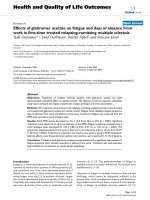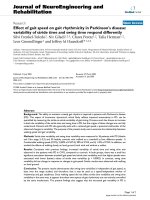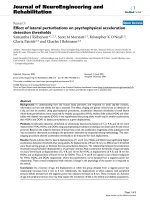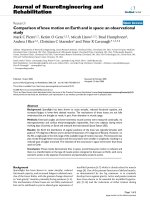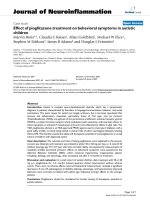Báo cáo hóa học: "CONTINUITY OF MULTILINEAR OPERATORS ON TRIEBEL-LIZORKIN SPACES" potx
Bạn đang xem bản rút gọn của tài liệu. Xem và tải ngay bản đầy đủ của tài liệu tại đây (513.68 KB, 11 trang )
CONTINUITY OF MULTILINEAR OPERATORS ON
TRIEBEL-LIZORKIN SPACES
LANZHE LIU
Received 4 February 2006; Revised 20 September 2006; Accepted 28 September 2006
The continuity of some multilinear operators related to certain convolution operators on
the Triebel-Lizorkin space is obtained. The operators include Littlewood-Paley operator
and Marcinkiewi cz operator.
Copyright © 2006 Lanzhe Liu. This is an open access article distributed under the Cre-
ative Commons Attribution License, which permits unrestricted use, distribution, and
reproduction in any medium, provided the original work is properly cited.
1. Introduction
Let T be the Calder
´
on-Zygmund singular integral operator, a well-known result of Coif-
man et al. (see [6]) states that the commutator [b,T]( f )
= T(bf) −bT(f )(whereb ∈
BMO) is bounded on L
p
(R
n
)(1<p<∞); Chanillo (see [1]) proves a similar result when
T is replaced by the fractional integr al operator; in [8, 9], these results on the Triebel-
Lizorkin spaces and the case b
∈ Lipβ (where Lipβ is the homogeneous Lipschitz space)
are obtained. The main purpose of this paper is to study the continuity of some multi-
linear operators related to certain convolution operators on the Triebel-Lizorkin spaces.
In fact, we will obtain the continuity on the Triebel-Lizorkin spaces for the multilinear
operators only under certain conditions on the size of the operators. As the applications,
the continuity of the multilinear operators related to the Littlewood-Paley oper ator and
Marcinkiewicz operator on the Triebel-Lizorkin spaces are obtained.
2. Notations and results
Throughout this paper, Q will denote a cube of R
n
with side parallel to the axes, and
for a cube Q,let f
Q
=|Q|
−1
Q
f (x)dx and f
#
(x) = sup
x∈Q
|Q|
−1
Q
|f (y) − f
Q
|dy.For
1
≤ r<∞ and 0 ≤δ<n,let
M
δ,r
( f )(x) =sup
x∈Q
1
|Q|
1−δr/n
Q
f (y)
r
dy
1/r
, (2.1)
Hindawi Publishing Corporation
Journal of Inequalities and Applications
Volume 2006, Article ID 58473, Pages 1–11
DOI 10.1155/JIA/2006/58473
2 Continuity of multilinear operators
we denote M
δ,r
( f ) = M
r
( f )ifδ = 0, which is the Hardy-Littlewood maximal function
when r
= 1 (see [10]). For β>0andp>1, let
˙
F
β,∞
p
be the homogeneous Triebel-Lizorkin
space, and let the Lipschitz space
˙
∧
β
be the space of functions f such that
f
˙
∧
β
= sup
x, h∈R
n
, h=0
Δ
[β]+1
h
f (x)
|h|
β
< ∞
, (2.2)
where Δ
k
h
denotes the kth difference operator (see [9]).
We are going to study the multilinear operator as follows.
Let m be a positive integer and let A be a function on R
n
. We denote
R
m+1
(A;x, y) =A(x) −
|α|≤m
1
α!
D
α
A(y)(x − y)
α
. (2.3)
Definit ion 2.1. Let F(x,t)defineonR
n
×[0,+∞), denote
F
t
( f )(x) =
R
n
F(x − y,t) f (y)dy,
F
A
t
( f )(x) =
R
n
R
m+1
(A;x, y)
|x − y|
m
F(x − y,t) f (y)dy.
(2.4)
Let H be the Hilbert space H
={h : h< ∞}such that, for each fixed x ∈ R
n
, F
t
( f )(x)
and F
A
t
( f )(x) may be viewed as a mapping from [0,+∞)toH. Then, the multilinear
operators related to F
t
is defined by
T
A
( f )(x) =
F
A
t
( f )(x)
; (2.5)
and also define T(f )(x)
=F
t
( f )(x).
In particular, consider the following two sublinear operators.
Definit ion 2.2. Fix ε>0, n>δ
≥ 0. Let ψ be a fixed function which satisfies the following
properties:
(1)
ψ(x)dx =0;
(2)
|ψ(x)|≤C(1 + |x|)
−(n+1−δ)
;
(3)
|ψ(x + y) −ψ(x)|≤C|y|
ε
(1 + |x|)
−(n+1+ε−δ)
when 2|y| < |x|.
The multilinear Littlewood-Paley operator is defined by
g
A
δ
( f )(x) =
∞
0
F
A
t
( f )(x)
2
dt
t
1/2
, (2.6)
where
F
A
t
( f )(x) =
R
n
R
m+1
(A;x, y)
|x − y|
m
ψ
t
(x − y) f (y)dy (2.7)
Lanzhe Liu 3
and ψ
t
(x) =t
−n+δ
ψ(x/t)fort>0. Denote that F
t
( f ) =ψ
t
∗ f , and also define that
g
δ
( f )(x) =
∞
0
F
t
( f )(x)
2
dt
t
1/2
, (2.8)
which is the Littlewood-Paley g function w hen δ
= 0 (see [11]).
Let H be the space H
={h : h=(
∞
0
|h(t)|
2
dt/t)
1/2
< ∞},then,foreachfixedx ∈ R
n
,
F
A
t
( f )(x) may be viewed as a mapping from [0,+∞)toH, and it is clear that
g
δ
( f )(x) =
F
t
( f )(x)
, g
A
δ
( f )(x) =
F
A
t
( f )(x)
. (2.9)
Definit ion 2.3. Let 0
≤ δ<n,0<γ≤ 1andΩ be homogeneous of degree zero on R
n
such that
S
n−1
Ω(x
)dσ(x
) = 0. Assume that Ω ∈ Lip
γ
(S
n−1
), that is, there exists a con-
stant M>0 such that for any x, y
∈ S
n−1
, |Ω(x) −Ω(y)|≤M|x − y|
γ
. The multilinear
Marcinkiewicz operator is defined by
μ
A
δ
( f )(x) =
∞
0
F
A
t
( f )(x)
2
dt
t
3
1/2
, (2.10)
where
F
A
t
( f )(x) =
|x−y|≤t
Ω(x − y)
|x − y|
n−1−δ
R
m+1
(A;x, y)
|x − y|
m
f (y)dy; (2.11)
denote
F
t
( f )(x) =
|x−y|≤t
Ω(x − y)
|x − y|
n−1−δ
f (y)dy, (2.12)
and also define that
μ
δ
( f )(x) =
∞
0
F
t
( f )(x)
2
dt
t
3
1/2
, (2.13)
which is the Marcinkiewicz operator when δ
= 0 (see [12]).
Let H be the space H
={h : h=(
∞
0
|h(t)|
2
dt/t
3
)
1/2
< ∞}. Then, it is clear that
μ
δ
( f )(x) =
F
t
( f )(x)
, μ
A
δ
( f )(x) =
F
A
t
( f )(x)
. (2.14)
It is clear that Definitions 2.2 and 2.3 are the particular examples of Definition 2.1.
Note that when m
= 0, T
A
is just the commutator of F
t
and A, while when m>0, it is
nontrivial generalizations of the commutators. It is well known that multilinear oper-
ators are of great interest in harmonic analysis and have been widely studied by many
authors (see [2–5, 7]). The main purpose of this paper is to study the continuity for the
multilinear opera tors on the Triebel-Lizorkin spaces. We will prove the following theo-
rems in Section 3.
Theorem 2.4. Let g
A
δ
be the mult ilinear Littlewood-Paley operator as in Definition 2.2.If
0 <β<min(1,ε) and D
α
A ∈
˙
∧
β
for |α|=m, then
4 Continuity of multilinear operators
(a) g
A
δ
maps L
p
(R
n
) continuously into
˙
F
β,∞
q
(R
n
),for1 <p<n/δand 1/q = 1/p−δ/n;
(b) g
A
δ
maps L
p
(R
n
) continuously into L
q
(R
n
) for 1 <p<n/(δ + β) and 1/p− 1/q =
(δ +β)/n.
Theorem 2.5. Let μ
A
δ
be the multilinear Marcinkiewiz operator as in Definition 2.3.If0 <
β<min(1/2, γ) and D
α
A ∈
˙
∧
β
for |α|=m, then
(a) μ
A
δ
maps L
p
(R
n
) continuously into
˙
F
β,∞
q
(R
n
) for 1 <p<n/δand 1/q =1/p−δ/n,
(b) μ
A
δ
maps L
p
(R
n
) continuously into L
q
(R
n
) for 1 <p<n/(δ + β) and 1/p−1/q =
(δ +β)/n.
3. Main theorem and proof
We first prove a general theorem.
Theorem 3.1 (main theorem). Let 0
≤ δ<n, 0 <β<1,andD
α
A ∈
˙
∧
β
for |α|=m.Sup-
pose F
t
, T,andT
A
are the same as in Definition 2.1,ifT is bounded from L
p
(R
n
) to L
q
(R
n
)
for 1 <p<n/δand 1/q
= 1/p−δ/n,andT satisfies the following size condition:
F
A
t
( f )(x) −F
A
t
( f )
x
0
≤
C
|α|=m
D
α
A
˙
∧
β
|Q|
β/n
M
δ,1
f (x) (3.1)
for any cube Q with supp f
⊂ (2Q)
c
and x ∈Q, then
(a) T
A
is bounded from L
p
(R
n
) to
˙
F
β,∞
q
(R
n
) for 1 <p<n/δand 1/q =1/p−δ/n,
(b) T
A
is bounded from L
p
(R
n
) to L
q
(R
n
) for 1 <p<n/(δ + β) and 1/q = 1/p−(δ +
β)/n.
To prove the theorem, we need the following lemmas.
Lemma 3.2 (see [9]). For 0 <β<1, 1 <p<
∞,
f
˙
F
β,∞
p
≈
sup
Q
1
|Q|
1+β/n
Q
f (x) − f
Q
dx
L
p
≈
sup
·∈Q
inf
c
1
|Q|
1+β/n
Q
f (x) −c
dx
L
p
.
(3.2)
Lemma 3.3 (see [9]). For 0 <β<1, 1
≤ p ≤∞,
f
˙
∧
β
≈ sup
Q
1
|Q|
1+β/n
Q
f (x) − f
Q
dx
≈ sup
Q
1
|Q|
β/n
1
|Q|
Q
f (x) − f
Q
p
dx
1/p
.
(3.3)
Lemma 3.4 (see [1, 2]). Suppose that 1
≤ r<p<n/δand 1/q = 1/p−δ/n. Then
M
δ,r
( f )
L
q
≤ Cf
L
p
. (3.4)
Lanzhe Liu 5
Lemma 3.5 (see [5]). Let A be a function on R
n
and D
α
A ∈L
q
(R
n
) for |α|=m and some
q>n. Then
R
m
(A;x, y)
≤
C|x − y|
m
|α|=m
1
Q(x, y)
Q(x,y)
D
α
A(z)
q
dz
1/q
, (3.5)
where
Q(x, y) isthecubecenteredatx and has side length 5
√
n|x − y|.
Proof of Theorem 3.1 (main theorem). Fix a cube Q
= Q(x
0
,l)andx ∈ Q.Let
Q = 5
√
nQ
and
A(x) = A(x) −
|α|=m
(1/α!)(D
α
A)
Q
x
α
,thenR
m
(A;x, y) = R
m
(
A;x, y)andD
α
A =
D
α
A −(D
α
A)
Q
for |α|=m.Wewrite,for f
1
= fχ
Q
and f
2
= fχ
R
n
\
Q
,
F
A
t
( f )(x) =
R
n
R
m+1
A;x, y
|x − y|
m
F(x − y,t) f (y)dy
=
R
n
R
m+1
A;x, y
|x − y|
m
F(x − y,t) f
2
(y)dy
+
R
n
R
m
A;x, y
|x − y|
m
F(x − y,t) f
1
(y)dy
−
|α|=m
1
α!
R
n
F(x − y,t)(x − y)
α
|x − y|
m
D
α
A(y) f
1
(y)dy,
(3.6)
then
T
A
( f )(x) −T
A
f
2
x
0
=
F
A
t
( f )(x)
−
F
A
t
f
2
x
0
≤
F
t
R
m
A;x,·
|x −·|
m
f
1
(x)
+
|α|=m
1
α!
F
t
(x −·)
α
|x −·|
m
D
α
Af
1
(x)
+
F
A
t
f
2
(x) −F
A
t
f
2
x
0
=
A(x)+B(x)+C(x),
(3.7)
thus,
1
|Q|
1+β/n
Q
T
A
( f )(x) −T
A
( f )
x
0
dx
≤
1
|Q|
1+β/n
Q
A(x)dx +
1
|Q|
1+β/n
Q
B(x)dx
+
1
|Q|
1+β/n
Q
C(x)dx :=I + II +III.
(3.8)
6 Continuity of multilinear operators
Now, let us estimate I, II,andIII, respectively. First, for x
∈ Q and y ∈
Q, using Lemmas
3.3 and 3.5,weget
R
m
A;x, y
≤
C|x − y|
m
|α|=m
sup
x∈
Q
D
α
A(x) −
D
α
A
Q
≤
C|x − y|
m
|Q|
β/n
|α|=m
D
α
A
˙
∧
β
,
(3.9)
thus, taking r, s such that 1
≤ r<pand 1/s =1/r −δ/n,bythe(L
r
,L
s
) boundedness of T
and Holder’ inequality, we obtain
I
≤ C
|α|=m
D
α
A
˙
∧
β
1
|Q|
Q
T
f
1
(x)
dx ≤ C
|α|=m
D
α
A
˙
∧
β
T
f
1
L
s
|Q|
−1/s
≤ C
|α|=m
D
α
A
˙
∧
β
f
1
L
r
|Q|
−1/s
≤ C
|α|=m
D
α
A
˙
∧
β
M
δ,r
( f )(x).
(3.10)
Secondly, using the following inequality (see [9]):
D
α
A −
D
α
A
Q
fχ
Q
L
r
≤ C|Q|
1/s+β/n
D
α
A
˙
∧
β
M
δ,r
( f )(x), (3.11)
and similar to the proof of I,wegain
II
≤ C
|α|=m
D
α
A
˙
∧
β
M
δ,r
( f )(x). (3.12)
For III, using the size condition of T,wehave
III
≤ C
|α|=m
D
α
A
˙
∧
β
M
δ,1
( f )(x). (3.13)
We now put these estimates together; and taking the supremum over all Q such that
x ∈Q, and using Lemmas 3.2 and 3.4,weobtain
T
A
( f )
˙
F
β,∞
q
≤ C
|α|=m
D
α
A
˙
∧
β
f
L
p
. (3.14)
This completes the proof of (a).
(b) By same argument as in proof of (a), we have
1
|Q|
Q
T
A
( f )(x) −T
A
f
2
x
0
dx
≤ C
|α|=m
D
α
A
˙
∧
β
M
δ+β,r
( f )+M
δ+β,1
( f )
,
(3.15)
thus,
T
A
( f )
#
≤ C
|α|=m
D
α
A
˙
∧
β
M
δ+β,r
( f )+M
δ+β,1
( f )
. (3.16)
Lanzhe Liu 7
Now, using Lemma 3.4,wegain
T
A
( f )
L
q
≤ C
T
A
( f )
#
L
q
≤ C
|α|=m
D
α
A
˙
∧
β
M
δ+β,r
( f )
L
q
+
M
δ+β,1
( f )
L
q
≤
Cf
L
p
.
(3.17)
This completes the proof of (b) and the theorem.
To prove Th e or e m s 2.4 and 2.5, since g
δ
and μ
δ
are all bounded from L
p
(R
n
)toL
q
(R
n
)
for 1 <p<n/δand 1/q
= 1/p−δ/n (see [11, 12]), it suffices to verify that g
A
δ
and μ
A
δ
satisfy the size condition in Theorem 3.1 (main theorem).
Suppose supp f
⊂ (2Q)
c
and x ∈ Q = Q(x
0
,l). Note that |x
0
− y|≈|x − y| for y ∈
(2Q)
c
.
For g
A
δ
,wewrite
F
A
t
( f )(x) −F
A
t
( f )
x
0
=
R
n
\
Q
ψ
t
(x − y)
|x − y|
m
−
ψ
t
x
0
− y
x
0
− y
m
R
m
A;x, y
f (y)dy
+
R
n
\
Q
ψ
t
x
0
− y
f (y)
x
0
− y
m
R
m
A;x, y
−
R
m
A;x
0
, y
dy
−
|α|=m
1
α!
R
n
\
Q
ψ
t
(x − y)(x − y)
α
|x − y|
m
−
ψ
t
x
0
− y
x
0
− y
α
x
0
− y
m
D
α
A(y) f (y)dy
= I
1
+ I
2
+ I
3
.
(3.18)
By the condition on ψ,weobtain
I
1
≤
C
R
n
\
Q
x −x
0
x
0
− y
m+1
R
m
A;x, y
f (y)
∞
0
tdt
t +
x
0
− y
2(n+1−δ)
1/2
dy
+ C
R
n
\
Q
x −x
0
ε
x
0
− y
m
R
m
A;x, y
f (y)
∞
0
tdt
t +
x
0
− y
2(n+1+ε−δ)
1/2
dy
≤ C
|α|=m
D
α
A
˙
∧
β
|Q|
β/n
∞
k=0
2
k+1
Q\2
k+1
Q
x −x
0
x
0
− y
n+1−δ
+
x −x
0
ε
x
0
− y
n+ε−δ
f (y)
dy
≤ C
|α|=m
D
α
A
˙
∧
β
|Q|
β/n
∞
k=1
2
−k
+2
−kε
1
2
k
Q
1−δ/n
2
k
Q
f (y)
dy
≤
C
|α|=m
D
α
A
˙
∧
β
|Q|
β/n
M
δ,1
( f )(x).
(3.19)
8 Continuity of multilinear operators
For I
2
, by the formula (see [5]):
R
m
A;x, y
−
R
m
A;x
0
, y
=
|η|<m
1
η!
R
m−|η|
D
η
A;x,x
0
(x − y)
η
(3.20)
and Lemma 3.5,weget
R
m
A;x, y
−
R
m
A;x
0
, y
≤
C
|α|=m
D
α
A
˙
∧
β
|Q|
β/n
x −x
0
x
0
− y
m−1
, (3.21)
thus, similar to the proof of I
1
,
I
2
≤
C
R
n
\
Q
R
m
A;x, y
−
R
m
A;x
0
, y
x
0
− y
m+n−δ
f (y)
dy
≤ C
|α|=m
D
α
A
˙
∧
β
|Q|
β/n
∞
k=0
2
k+1
Q\2
k
Q
x −x
0
x
0
− y
n+1−δ
f (y)
dy
≤ C
|α|=m
D
α
A
˙
∧
β
|Q|
β/n
M
δ,1
( f )(x).
(3.22)
For I
3
, similar to the proof of I
1
,weobtain
I
3
≤
C
|α|=m
R
n
\
Q
x −x
0
x
0
− y
n+1−δ
+
x −x
0
ε
x
0
− y
n+ε−δ
f (y)
D
α
A(y)
dy
≤ C
|α|=m
D
α
A
˙
∧
β
|Q|
β/n
∞
k=1
2
k(β−1)
+2
k(β−ε)
M
δ,1
( f )(x)
≤ C
|α|=m
D
α
A
˙
∧
β
|Q|
β/n
M
δ,1
( f )(x)
(3.23)
so that
F
A
t
( f )(x) −F
A
t
( f )
x
0
≤
C
|α|=m
D
α
A
˙
∧
β
|Q|
β/n
M
δ,1
( f )(x). (3.24)
Lanzhe Liu 9
For μ
A
δ
,wewrite
F
A
t
( f )(x) −F
A
t
( f )
x
0
≤
∞
0
|x−y|≤t, |x
0
−y|>t
Ω(x − y)
R
m
A;x, y
|x − y|
m+n−1−δ
f (y)
dy
2
dt
t
3
1/2
+
∞
0
|x−y|>t, |x
0
−y|≤t
Ω
x
0
− y
R
m
A;x
0
, y
x
0
− y
m+n−1−δ
f (y)
dy
2
dt
t
3
1/2
+
∞
0
|x−y|≤t,|x
0
−y|≤t
Ω(x − y)R
m
(
A;x, y)
|x − y|
m+n−1−δ
−
Ω
x
0
− y
R
m
A;x
0
, y
x
0
− y
m+n−1−δ
f (y)
dy
2
dt
t
3
1/2
+ C
|α|=m
∞
0
|x−y|≤t
Ω(x − y)(x − y)
α
|x − y|
m+n−1−δ
−
|x
0
−y|≤t
Ω
x
0
− y
x
0
− y
α
x
0
− y
m+n−1−δ
×
D
α
A(y) f (y)dy
2
dt
t
3
1/2
:= J
1
+ J
2
+ J
3
+ J
4
.
(3.25)
Then
J
1
≤ C
R
n
\
Q
f (y)
R
m
A;x, y
|x − y|
m+n−1−δ
|x−y|≤t<|x
0
−y|
dt
t
3
1/2
dy
≤ C
R
n
\
Q
f (y)
R
m
A;x, y
|x − y|
m+n−1−δ
x
0
−x
1/2
|x − y|
3/2
dy
≤ C
|α|=m
D
α
A
˙
∧
β
|Q|
β/n
∞
k=1
2
−k/2
1
2
k
Q
1−δ/n
2
k
Q
f (y)
dy
≤ C
|α|=m
D
α
A
˙
∧
β
|Q|
β/n
M
δ,1
( f )(x),
(3.26)
similarly, we have J
2
≤ C
|α|=m
D
α
A
˙
∧
β
|Q|
β/n
M
δ,1
( f )(x).
For J
3
, by the following inequality (see [12]):
Ω(x − y)
|x − y|
m+n−1−δ
−
Ω
x
0
− y
x
0
− y
m+n−1−δ
≤
C
x −x
0
x
0
− y
m+n−δ
+
x −x
0
γ
x
0
− y
m+n−1−δ+γ
,
(3.27)
10 Continuity of multilinear operators
we gain
J
3
≤ C
|α|=m
D
α
A
˙
∧
β
|Q|
β/n
R
n
\
Q
x −x
0
x
0
− y
n−δ
+
x −x
0
γ
x
0
− y
n−1−δ+γ
×
|x
0
−y|≤t, |x−y|≤t
dt
t
3
1/2
f (y)
dy
≤ C
|α|=m
D
α
A
˙
∧
β
|Q|
β/n
∞
k=1
2
−k
+2
−γk
M
δ,1
( f )(x)
≤ C
|α|=m
D
α
A
˙
∧
β
|Q|
β/n
M
δ,1
( f )(x).
(3.28)
For J
4
, similar to the proof of J
1
, J
2
,andJ
3
,weobtain
J
4
≤ C
|α|=m
R
n
\
Q
x −x
0
x
0
− y
n+1−δ
+
x −x
0
1/2
x
0
− y
n+1/2−δ
+
x −x
0
γ
x
0
− y
n+γ−δ
×
D
α
A(y)
f (y)
dy
≤ C
|α|=m
D
α
A
˙
∧
β
|Q|
β/n
∞
k=1
2
k(β−1)
+2
k(β−1/2)
+2
k(β−γ)
1
2
k
Q
2
k
Q
f (y)
dy
≤ C
|α|=m
D
α
A
˙
∧
β
|Q|
β/n
M
δ,1
( f )(x).
(3.29)
These yield the desired results.
Acknowledgment
The author would like to express his gratitude to the referee for his comments and sug-
gestions.
References
[1] S. Chanillo, Anoteoncommutators, Indiana University Mathematics Journal 31 (1982), no. 1,
7–16.
[2] W. Chen, A Besov estimate for multilinear singular integrals, Acta Mathematica Sinica. English
Series 16 (2000), no. 4, 613–626.
[3] J. Cohen, A sharp est i mate for a multilinear singular integral in R
n
, Indiana University Mathe-
matics Journal 30 (1981), no. 5, 693–702.
[4] J.CohenandJ.A.Gosselin,On mult ilinear singular integrals on R
n
, Studia Mathematica 72
(1982), no. 3, 199–223.
[5]
, A BMO estimate for multilinear singular integrals, Illinois Journal of Mathematics 30
(1986), no. 3, 445–464.
[6] R. R. Coifman, R. Rochberg, and G. Weiss, Factorization theorems for Hardy spaces in several
variables, Annals of Mathematics. Second Series 103 (1976), no. 3, 611–635.
Lanzhe Liu 11
[7] Y. Ding and S. Z. Lu, Weighted boundedness for a class of rough multilinear operators,ActaMath-
ematica Sinica. English Series 17 (2001), no. 3, 517–526.
[8] S. Janson, Mean oscillation and commutators of singular i ntegral operators,Arkivf
¨
or Matematik
16 (1978), no. 2, 263–270.
[9] M. Paluszy
´
nski, Characterization of the Besov spaces via the commutator operator of Coifman,
Rochberg and W eiss, Indiana University Mathematics Journal 44 (1995), no. 1, 1–17.
[10] E. M. Stein, Harmonic Analysis: Real-Variable Methods, Orthogonality, and Oscillatory Integrals,
Princeton Mathematical Series, vol. 43, Princeton University Press, New Jersey, 1993.
[11] A. Torchinsky, Real-Variable Methods in Harmonic Analysis, Pure and Applied Mathematics, vol.
123, Academic Press, Florida, 1986.
[12] A. Torchinsky and S. L. Wang, A note on the Marcinkiewicz integral, Colloquium Mathematicum
60/61 (1990), no. 1, 235–243.
Lanzhe Liu: Department of Mathematics, Changsha University of Science and Technology,
Changsha 410077, China
E-mail address:


